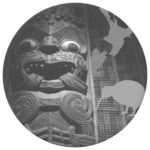
Back أدب نيوزيلندي Arabic নিউজিল্যান্ডের সাহিত্য Bengali/Bangla Neuseeländische Literatur German Littérature néo-zélandaise French Új-Zéland irodalma Hungarian Նոր Զելանդիայի գրականություն Armenian ニュージーランド文学 Japanese 뉴질랜드 문학 Korean Литература Новой Зеландии Russian නවසීලන්ත සාහිත්යය Singhalese
| Part of a series on the |
| Culture of New Zealand |
|---|
 |
New Zealand literature is literature, both oral and written, produced by the people of New Zealand. It often deals with New Zealand themes, people or places, is written predominantly in New Zealand English, and features Māori culture and the use of the Māori language. Before the arrival and settlement of Europeans in New Zealand in the 19th century, Māori culture had a strong oral tradition. Early European settlers wrote about their experiences travelling and exploring New Zealand. The concept of a "New Zealand literature", as distinct from English literature, did not originate until the 20th century, when authors began exploring themes of landscape, isolation, and the emerging New Zealand national identity.[1][2] Māori writers became more prominent in the latter half of the 20th century, and Māori language and culture have become an increasingly important part of New Zealand literature.[2]
New Zealand literature has developed into a major part of modern New Zealand culture through a growing readership, financial support and publicity for writers through literary awards and fellowships, and the development of literary journals and magazines. Many New Zealand writers have obtained local and international renown over the years, including the short-story writers Katherine Mansfield, Frank Sargeson and Jacquie Sturm, novelists Janet Frame, Patricia Grace, Witi Ihimaera, Maurice Gee, Keri Hulme and Eleanor Catton, poets James K. Baxter, Fleur Adcock, Selina Tusitala Marsh and Hone Tuwhare, children's authors Margaret Mahy and Joy Cowley, historians Michael King and Judith Binney, and playwright Roger Hall.
- ^ "Making of New Zealand literature". New Zealand History. Manatū Taonga, the Ministry for Culture and Heritage. Archived from the original on 14 November 2016. Retrieved 14 February 2021.
- ^ a b Stead, C.K., New Zealand literature at the Encyclopædia Britannica.
© MMXXIII Rich X Search. We shall prevail. All rights reserved. Rich X Search